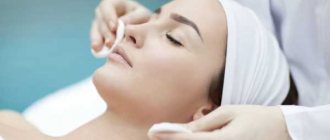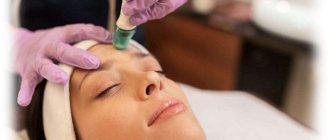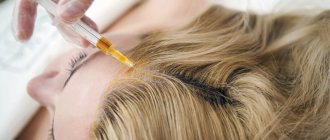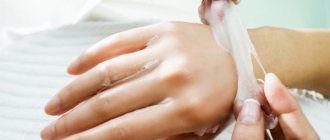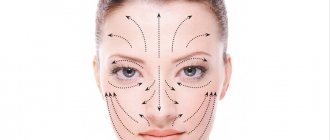Mesotherapy is an injection procedure that involves the subcutaneous administration of special drugs. Since the technique involves creating many punctures on the skin, there are quite a lot of contraindications prescribed for it. One of the popular questions from girls is “Is it possible to do mesotherapy during menstruation?” In fact, cosmetologists have different answers to this question, so let’s look at the specifics of the technique and the possibility of carrying it out during this period.
The essence of the procedure
Before you find out whether mesotherapy can be done during menstruation, it is important to understand the essence of the technique itself, since many girls begin to get acquainted with it from a cosmetologist.
Mesotherapy is a minimally invasive cosmetic procedure that involves the introduction of special mesotherapy cocktails into the structure of the dermis, which saturate the epithelial cells with useful substances and awaken natural processes that slow down with age.
If we talk about the impact on the internal microflora of tissues, the procedure promotes:
- Acceleration of blood microcirculation;
- Improving metabolism;
- Active production of collagen and elastin;
- Activation of regeneration of new epithelial cells.
In the classic version of mesotherapy, the cosmetologist creates many small punctures on the skin, through which the drug quickly penetrates the cells.
However, there is also non-injection mesotherapy, which involves the impact of electromagnetic pulses on tissue.
The procedure is prescribed for the following skin problems:
- Flabbiness, dullness of the skin.
- Pigmentation.
- Acne and post-acne.
- Enlarged pores.
- Stretch marks, scars.
- Dark circles and bags under the eyes.
- Wrinkles.
- Fuzzy oval face.
In any case, mesotherapy has a cumulative effect, so it is impossible to achieve the desired result in 1-2 sessions. Typically, a girl has to undergo a course consisting of 8-12 visits to cosmetology.
Compatible with menstruation
Mesotherapy during menstruation is one of the relative contraindications prescribed by cosmetologists, since the procedure involves injection tissue damage, and, accordingly, an effect on the internal microflora of the body.
Mesotherapy most often does not affect the stability of the cycle and hormonal changes that occur during menstruation. On the contrary, surges in hormones in the blood can lead to ambiguous side effects after visiting cosmetology.
In addition, during menstruation, a girl’s body becomes more susceptible to external irritants. Injection cosmetic procedures are one of them.
Reasons for limitation
As mentioned above, changes in a girl’s body during her critical days can lead to various undesirable consequences and side effects, which can affect not only your well-being, but also the effectiveness of mesotherapy.
Reduced pain threshold
One of the most pronounced symptoms that girls notice when visiting cosmetology during menstruation. The skin becomes more sensitive, which is why having multiple punctures on it can become not only unpleasant, but also painful.
Most often, no anesthetic is used before mesotherapy, but in this case you can ask the specialist to apply a local anesthetic in the form of a cream or gel. But then the risk of side effects increases, which is associated with the use of additional medications.
In addition, the long-term maintenance of the effect of the anesthetic during menstruation is also reduced.
Mood instability
The symptom appears in most girls during menstruation, since it is associated with hormonal surges in the body.
It may not greatly affect the quality of mesotherapy, but it will most likely not be easy for you to endure the session mentally. And in combination with a lowered pain threshold, your reaction to injections may be ambiguous, which can make it difficult for a cosmetologist to complete the technology correctly.
Inflammatory processes on the skin
Quite often, due to an increase in the level of specific enzymes in a girl’s body during menstruation, various inflammations appear on her - pimples, blackheads, enlarged pores, blackheads. They usually pass quite quickly, but can affect the effectiveness of mesotherapy.
One of the contraindications to mesotherapy is skin diseases and open lesions in the treated area. This can also include active acne, so you should treat this consequence with the utmost care.
Decreased blood clotting
One of the main health restrictions that are prescribed for mesotherapy is a low blood clotting rate. Because of this, girls are not allowed to perform the procedure even if they have diabetes.
The contraindication is due to the fact that mesotherapy involves mechanical damage to the skin in the treated area. When creating deep punctures, microtraumas may appear in the dermis, causing small bruises. With a low blood clotting rate, the skin will take much longer to heal.
In addition, in this case, the absorption of the meso-cocktail will be much worse, which reduces the effectiveness of the manipulations.
Recommendations after cryolipolysis
Correcting your figure through sports or diet is a difficult and tedious task; in addition, such measures are often not enough to restore harmony. And then cryolipolysis can come to the rescue. Many patients are interested in what it is, what to do after the cryolipolysis procedure, and how the rehabilitation goes. Cryolipolysis is a method of applying cold to subcutaneous fat tissue in order to eliminate the fat layer and correct the figure. The procedure is performed non-invasively, the impact is controlled and does not cause harm to health. How is fat removed after cryolipolysis? The effect is based on local cooling of fat tissue. Prolonged cooling of cells leads to their death, while surrounding tissues are not damaged. This process is safe for the body, since there is no pronounced inflammation and no release of the breakdown product of fat cells into the circulatory system. The treatment area can be almost any - the procedure is carried out on the back and abdomen, thighs, arms, legs.
Cryolipolysis procedure
Cryolipolysis is a non-invasive hardware method of influencing fat deposits locally. When cryolipolysis is performed in cooled cells, the process of energy deficiency starts, as a result of which their vital activity fades away and they are excreted during natural metabolic processes. The impact provokes intracellular fat burning. Main advantages:
• No surgical intervention is expected; • The procedure is performed without pain; • There is no long-term rehabilitation; • Adverse reactions are kept to a minimum; • You can evaluate the result almost immediately.
The service is performed by qualified specialists at the Medial clinic. The goals of cryolipolysis are to eliminate excess fat. The procedure does not affect the skin, muscles, or vascular beds. The effect is considered delicate, since the integrity of the dermis is not compromised. No preliminary anesthesia or long-term rehabilitation is required, there are no scars or scars. This procedure is a good alternative to surgery. Almost immediately after the procedure, you can return to your normal lifestyle. The manipulation takes place with comfort for the patient; it can be done by both women and men who dream of a beautiful, slender figure. If you follow your doctor's recommendations, the results will last for a long time.
The manipulation is performed in several stages. The doctor first examines the area that requires correction and plans the procedure. Before using the applicator, a special layer of gel is applied to the skin to avoid hypothermia. The applicator is fixed using a fastener. He pulls the fold inside the bowl. If it is not equipped with a vacuum, the applicator is placed on the area to be corrected. After cryolipolysis of the abdominal area, the lower abdomen may hurt, minor bruising and numbness are possible. These adverse reactions normally go away on their own. In which areas is cryolipolysis used:
• Removal of excess fat in the abdominal area; • Elimination of fat on the sides and formation of curves; • Correction of the hips and upper arms; • Elimination of double chin and excess fatty tissue in the lower jaw area; • Elimination of folds above the knees, near the palms.
The procedure is performed after 18 years of age. Manipulation is not performed during pregnancy and breastfeeding, or in the presence of severe chronic pathologies. Contraindications include the presence of autoimmune pathologies, inflammation in the area of treatment, infections, and oncology. Many patients are interested in what needs to be done after cryolipolysis if the dermis has become more sensitive. This reaction is normal and goes away on its own. The reduction in the fat layer occurs gradually. You can notice obvious results in about 8 weeks.
Rehabilitation after cryolipolysis
Cryolipolysis is the removal of fat using cold. Any procedure, including this one, has nuances in preparation and restrictions after it. A preliminary consultation and initial examination is carried out. This is required to exclude possible contraindications. Lengthy preparation is not needed, since the technique is non-invasive and acts locally on fat cells. As recommended by your doctor, you need to drink enough water several days before the session. You should avoid fatty or smoked foods. 2 weeks before the procedure, it is advisable to stop using chemical peels and limit the consumption of coffee and alcohol. You can't sunbathe. It is recommended to refuse food 2 hours before the procedure. Immediately after the session, the skin becomes reddish and numbness is felt. What should you not do after cryolipolysis? It is not recommended to eat food within 2 hours after the procedure and sunbathe. In addition, you should not steam the dermis for the first few days or actively engage in sports.
What to do after cryolipolysis
After performing the manipulation, side reactions may occur, which normally go away on their own. If the skin is sensitive, bruising, loss of sensitivity, and pain may occur. After the session, you must follow the doctor's recommendations. The repeated procedure is performed no earlier than three months later. To consolidate the result, a special massage may be prescribed and a nutrition plan developed. Is it possible to drink alcohol after cryolipolysis? No, this is undesirable, as it provokes swelling and negatively affects metabolic processes.
What not to do after cryolipolysis
After the procedure, it is not recommended to overheat the skin, visit baths, saunas, solariums or sunbathe in the open sun. Avoid aggressive procedures such as laser resurfacing, tattooing, peeling and scrubbing. You can return to your previous lifestyle, however, you cannot actively engage in sports for a while. After the procedure, recommendations are given to each patient individually by the doctor who conducted the session.
How to enhance the results after cryolipolysis
In order for the results to be positive for a long time, it is important to eat right. It is recommended to limit fatty foods, simple carbohydrates - sweets, flour, alcohol. After the skin has been restored, you can train as usual - sports help to tighten the body and make it more sculpted. It is necessary to maintain a drinking regime and consume sufficient amounts of liquid; it is recommended to reduce salt intake.
FAQ
Many patients are interested in what contraindications and side effects there are when performing the procedure.
The question often arises whether cryolipolysis can be done during menstruation, pregnancy, or breastfeeding. All your questions will be answered by a doctor who will conduct an initial consultation and examination. Is it possible to do the procedure during menstruation?
Cryolipolysis and menstruation are compatible. But, despite the fact that the procedure is relatively painless and has few restrictions, sensitivity increases during menstruation. The procedure can be unpleasant and the risk of adverse reactions increases. The effectiveness of the technique is not reduced, however, the risk of discomfort is high. In addition, manipulation is not performed if you are allergic to cold, if you have skin diseases or severe chronic pathologies.
Alcohol and cryolipolysis
Alcoholic drinks have a negative impact on your figure - they contribute to the appearance of fat deposits, especially in the abdominal area. A few days before and after the procedure, you need to give up alcohol. To maintain a positive result after therapy, it is important to eat properly and, if possible, completely eliminate alcohol from the diet, as well as limit the consumption of salty and floury, smoked and fatty foods.
Cryolipolysis during pregnancy
Pregnancy is one of the contraindications to the procedure. When carrying a child, it is advisable to exclude any stressful effects on the body. In addition, the result may be mild or completely absent, since hormonal levels are constantly changing. It is also impossible to exclude adverse reactions after the procedure, which can cause discomfort and stress. In this regard, doctors do not perform such a procedure during pregnancy, but it can be performed to restore the figure after childbirth.
Cryolipolysis during breastfeeding
This procedure is not recommended during breastfeeding. This is due to the fact that during breastfeeding, hormonal levels change and it is difficult to predict the body’s response to the loss of fat cells. In addition, lactation disturbances cannot be ruled out as a reaction to stress in the form of cold. Therefore, manipulation is recommended after breastfeeding has ended.
When can you exercise after cryolipolysis?
To enhance the positive result after the procedure, it is important to follow all recommendations from specialists. It is necessary to consume enough water - at least 1.5 liters daily. There is no need to significantly limit your usual lifestyle. Recovery on average takes 1-3 days, after which you can engage in sports, including active training. Periodic exercise will help you stay fit and speed up metabolic processes, improve your appearance and overall health. Low-intensity training is possible the very next day.
Opinions and advice from cosmetologists
Cosmetologists will not be able to strictly prohibit mesotherapy during menstruation. At a minimum, they will not be able to find out whether you have your period or not. However, in this case, you take all risks upon yourself, and be prepared for side effects and complications.
If we talk about when exactly it is not recommended to do mesotherapy, pay attention to the first few days. Most often, all the symptoms of menstruation appear especially clearly on days 1-3. Then the level of hormones in the body begins to stabilize, which is why side effects are eliminated.
Also, you should not do the procedure immediately before your period. Give your body a rest 1-2 days before.
When deciding to perform facial mesotherapy during menstrual periods, avoid areas of increased sensitivity: nose, eyelids, lips. In addition, first pay attention to the quality of the composition used in the salon and the literacy of the specialist who will perform the procedure.
In any case, before performing the procedure, it is important to make sure that there are no other contraindications to mesotherapy, since quite a lot of them are prescribed:
- Low blood clotting rate;
- Pregnancy, lactation period;
- Diabetes;
- Skin diseases;
- Fungus;
- Infectious and chronic diseases;
- Tumors;
- Diseases of the cardiovascular system;
- Individual intolerance to the components of the meso cocktail used.
Consult your doctor first so that he can examine yours and tell you how safe mesotherapy will be for you. This way you can not only reduce the risks of unwanted consequences, but you are also more likely to eliminate skin problems.
"Critical days
It’s not for nothing that menstruation is popularly called “critical” days. And not at all because, due to the ever-changing mood during this period, a crisis around a woman can arise literally out of the blue at home or at work. Although this does not happen without a reason.
A sharp change in a woman’s well-being before her period is triggered by a cessation of progesterone production and an increase in the amount of prostaglandins, which cause the onset of menstruation. As a result of this restructuring:
- the sensitivity of nerve endings increases;
- the excitability of the nervous system increases;
- causeless anxiety may appear;
- hemoglobin levels sharply decrease;
- Vascular spasms may occur;
- the blood thins slightly;
- The body's immune defense decreases.
Therefore, although menstruation is not a direct contraindication to mesotherapy, it is definitely not worth doing it during this period.


